
Biomechanics Principles and Applications - Donald R. Peterson & Joseph D. Bronzino
.pdf
7
Biomechanics
of Chest and Abdomen Impact
|
7.1 |
Introduction . . . . . . . . . . . . . . . . . . . . . . . . . . . . . . . . . . . . . . . . . . |
7-1 |
|
7.2 |
Chest and Abdomen Injury Mechanisms . . . . . . . . . . . . . . . |
7-1 |
|
7.3 |
Injury Criteria and Tolerances . . . . . . . . . . . . . . . . . . . . . . . . . |
7-2 |
|
|
Acceleration Injury • Force Injury • Compression Injury |
|
|
|
• Viscous Injury |
|
David C. Viano |
7.4 |
Biomechanical Responses During Impact . . . . . . . . . . . . . . |
7-6 |
Albert I. King |
7.5 |
Injury Risk Assessment . . . . . . . . . . . . . . . . . . . . . . . . . . . . . . . . |
7-9 |
Wayne State University |
References . . . . . . . . . . . . . . . . . . . . . . . . . . . . . . . . . . . . . . . . . . . . . . . . . . |
7-12 |
|
7.1 Introduction
Injury is caused by energy transfer to the body by an impacting object. It occurs when sufficient force is concentrated on the chest or abdomen by striking a blunt object, such as a vehicle instrument panel or side interior, or being struck by a baseball or blunt ballistic mass. The risk of injury is influenced by the object’s shape, stiffness, point of contact, and orientation. It can be reduced by energy absorbing padding or crushable materials, which allow the surfaces in contact to deform, extend the duration of impact, and reduce loads. The torso is viscoelastic, so reaction force increases with the speed of body deformation.
The biomechanical response of the body has three components: (1) inertial resistance by acceleration of body masses, (2) elastic resistance by compression of stiff structures and tissues, and (3) viscous resistance by rate-dependent properties of tissue. For low-impact speeds, the elastic stiffness protects from crush injuries; whereas, for high rates of body deformation, the inertial and viscous properties determine the force developed and limit deformation. The risk of skeletal and internal organ injury relates to energy stored or absorbed by the elastic and viscous properties. The reaction load is related to these responses and inertial resistance of body masses, which combine to resist deformation and prevent injury. When tissues are deformed beyond their recoverable limit, injuries occur.
7.2 Chest and Abdomen Injury Mechanisms
The primary mechanism of chest and abdomen injury is compression of the body at high rates of loading. This causes deformation and stretching of internal organs and vessels. When torso compression exceeds the rib-cage tolerance, fractures occur and internal organs and vessels can be contused or ruptured. In some
7-1

7-2 |
Biomechanics |
chest impacts, internal injury occurs without skeletal damage. This can happen during high-speed loading, such as with a baseball impact causing ventricular fibrillation in a child without rib fractures. Injury is due to the viscous or rate-sensitive nature of human tissue as biomechanical responses differ for lowand high-speed impact.
When organs or vessels are loaded slowly, the input energy is absorbed gradually through deformation, which is resisted by elastic properties and pressure buildup in tissue. This is the situation when the shoulder belt loads the upper body in a frontal crash. When loaded rapidly, reaction force is proportional to the speed of tissue deformation as the viscous properties of the body resist deformation and provide a natural protection from impact. However, there is also a considerable inertial component to the reaction force. In this case, the body develops high internal pressure and injuries can occur before the ribs deflect much. The ability of an organ or other biological system to absorb impact energy without failure is called tolerance.
If an artery is stretched beyond its tensile strength, the tissue will tear. Organs and vessels can be stretched in different ways, which result in different types of injury. Motion of the heart during chest compression stretches the aorta along its axis from points of tethering in the body. This elongation generally leads to a transverse laceration when the strain limit is exceeded. In contrast, an increase in vascular pressure dilates the vessel and produces biaxial strain, which is larger in the transverse than axial direction. If pressure rises beyond the vessel’s limit, it will burst. For severe impacts, intra-aortic pressure exceeds 500 to 1000 mm Hg, which is a significant, nonphysiological level, but is tolerable for short durations. When laceration occurs, the predominant mode of aortic failure is axial so the combined effects of stretch and internal pressure contribute to injury. Chest impact also compresses the rib cage causing tensile strain on the outer surface of the ribs. As compression increases, the risk of rib fracture increases. In both cases, the mechanism of injury is tissue deformation. Shah et al. [2001] found right-side impacts caused a higher risk of aortic injury than other impact directions.
The abdomen is more vulnerable to injury than the chest, because there is little bony structure below the ribcage to protect internal organs in front and lateral impact. Blunt impact of the upper abdomen can compress and injure the liver and spleen, before significant whole-body motion occurs. In the liver, compression increases intrahepatic pressure and generates tensile or shear strains. If the tissue is sufficiently deformed, laceration of the major hepatic vessels can result in hemoperitoneum. The injury tolerance of the solid organs in the abdomen is rate sensitive. Abdominal deformation also causes lobes of the liver to move relative to each other, stretching and shearing the vascular attachment at the hilar region.
Effective occupant restraints, safety systems, and protective equipment not only spread impact energy over the strongest body structures but also reduce contact velocity between the body and the impacted surface or striking object. The design of protective systems is aided by an understanding of injury mechanisms, quantification of human tolerance levels and development of numerical relationships between measurable engineering parameter, such as force, acceleration or deformation, and human injury. These relationships are called injury criteria.
7.3 Injury Criteria and Tolerances
7.3.1 Acceleration Injury
Stapp [1970] conducted rocket-sled experiments in the 1940s on belt-restraint systems and achieved a substantial human tolerance to long-duration, whole-body acceleration. Safety belts protected military personnel exposed to rapid but sustained acceleration. The experiments enabled Eiband [1959] to show in Figure 7.1 that the tolerance to whole-body acceleration increased as the exposure duration decreased. This linked human tolerance and acceleration for exposures of 2 to 1000 msec duration. The tolerance data is based on average sled acceleration rather than the acceleration of the volunteer subject, which would be higher due to compliance of the restraint system. Even with this limitation, the data provide useful early guidelines for the development of military and civilian restraint systems.
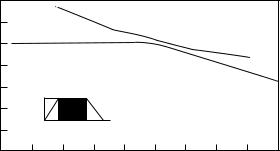
Biomechanics of Chest and Abdomen Impact |
7-3 |
Vehicle decleration (g)
200 |
|
100 |
Severe injury |
|
50
Minor or no injury
20
10 |
g |
|
5 |
t |
|
2 |
||
Duration |
1
1 |
2 |
5 |
10 |
20 |
50 |
100 |
1000 |
|
|
|
|
Duration (msec) |
|
||
FIGURE 7.1 Whole-body human tolerance to vehicle acceleration based on impact duration. (Redrawn from Eiband A.M. Human Tolerance to Rapidly Applied Acceleration. A Survey of the Literature. National Aeronautics and Space Administration, Washington DC, NASA Memo No. 5-19-59E, 1959 and Viano D.C., Bull. NY Acad. Med., 2nd Series, 64: 376–421, 1988. With permission.)
More recent side impact tests have led to other tolerance formulas for chest injury. Morgan et al. [1986] evaluated rigid, side-wall cadaver tests and developed TTI, a thoracic trauma index, which is the average rib and spine acceleration. TTI limits human tolerance to 85 to 90 g in vehicle crash tests. Better injury assessment was achieved by Cavanaugh et al. [1993] using average spinal acceleration (ASA), which is the average slope of the integral of spinal acceleration. ASA is the rate of momentum transfer during side impact, and a value of 30 g is proposed. In most cases, the torso can withstand 60 to 80 g peak, whole-body acceleration by a well-distributed load.
7.3.2 Force Injury
Whole-body tolerance is related to Newton’s second law of motion, where acceleration of a rigid mass is proportional to the force acting on it, or F = ma. While the human body is not a rigid mass, a welldistributed restraint system allows the torso to respond as though it were fairly rigid when load is applied through the shoulder and pelvis. The greater the acceleration, the greater the force and risk of injury. For a high-speed frontal crash, a restrained occupant can experience 60 g acceleration. For a body mass of 76 kg, the inertial load is 44.7 kN (10,000 lb) and is tolerable if distributed over strong skeletal elements for a short period of time.
The ability to withstand high acceleration for short durations implies that tolerance is related to momentum transfer, because an equivalent change in velocity can be achieved by increasing the acceleration and decreasing its duration, as V = a t. The implication for occupant-protection systems is that the risk of injury can be decreased if the crash deceleration is extended over a greater period of time. For occupant restraint in 25 msec, a velocity change of 14.7 m/sec (32.7 mph) occurs with 60 g whole-body acceleration. This duration can be achieved by crushable vehicle structures and occupant restraints [Mertz and Gadd, 1971].
Prior to the widespread use of safety belts, safety engineers needed information on the tolerance of the chest to design energy-absorbing instrument panels and steering systems. The concept was to limit impact force below human tolerance by crushable materials and structures. Using the highest practical crush force, safety was extended to the greatest severity of vehicle crashes. GM Research and Wayne State University collaborated on the development of the first crash sled, which was used to simulate progressively more severe frontal impacts. Embalmed human cadavers were exposed to head, chest, and knee impact on 15 cm (6 ) diameter load cells until bone fracture was observed on x-ray. Patrick et al. [1965,1967] demonstrated that blunt chest loading of 3.3 kN (740 lb) could be tolerated with minimal risk of serious injury. This is a pressure of 187 kPa. Gadd and Patrick [1968] later found a tolerance
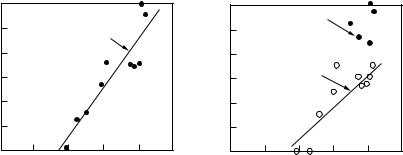
7-4 |
Biomechanics |
of 8.0 kN (1800 lb) if the load was distributed over the shoulders and chest by a properly designed steering wheel and column. Cavanaugh et al. [1993] found side-impact tolerance is similar to frontal tolerance, and that shoulder contact is also an important load-path. However, for the abdomen, side padding needs to crush at lower force than the abdominal tolerance to protect the liver and spleen [Viano and Andrzejak, 1993].
7.3.3 Compression Injury
High-speed films of cadaver impacts show that whole-body acceleration does not describe torso impact biomechanics. Tolerance of the chest and abdomen must consider body deformation. Force acting on the body causes two simultaneous responses: (1) compression of the compliant structures of the torso, and
(2) acceleration of body masses. The neglected mechanism of injury was compression, which causes the sternum to displace toward the spine as ribs bend and possibly fracture. Acceleration and force, per se, are not sufficient indicators of impact tolerance because they cannot discriminate between the two responses. Numerous studies have shown that acceleration is less related to injury than compression.
The importance of chest deformation was confirmed by Kroell et al. [1971,1974] in blunt thoracic impacts of unembalmed cadavers. Peak spinal acceleration and impact force were poorer injury predictors than the maximum compression of the chest, as measured by the percent change in the anteroposterior thickness of the body. A relationship was found between injury risk and compression and that it involves energy stored by elastic deformation of the body for moderate rates of chest compression. The stored energy (Es) by a spring representing the ribcage and soft tissues is related to the displacement integral of force: Es = F d x. Force in a spring is proportional to deformation: F = k x, where k is a spring constant representing the stiffness of the chest and is in the range of 26 kN/m. Stored energy is Es = k x dx = 0.5k x2. Over a compression range of 20 to 40%, stored energy is proportional to deformation or compression, so Es ≈ C .
Tests with human volunteers showed that compression up to 20% during moderate-duration loading was fully reversible. Cadaver impacts with compression greater than 20% showed (Figure 7.2a) an increase in rib fractures and internal organ injury as the compression increased to 40%. The deflection tolerance was originally set at 8.8 cm (3.5 ) for moderate but recoverable injury. This represents 39% compression. However, at this level of compression, multiple rib fractures and serious injury can occur, so a more conservative tolerance of 32% has been used to avert the possibility of flail chest (Figure 7.2b). This reduces the risk of direct loading on the heart, lungs, and internal organs by a loss of the protective function of the ribcage.
(a) 6
(AIS) |
5 |
|
4 |
||
severity |
||
3 |
||
Injury |
||
2 |
||
|
1
0
|
|
Overall injuries |
|
(b) |
6 |
|
|
|
|
|
|
|
|
|
|
|
Nonskeletal injury |
|
|
|
|||
|
|
AIS=0.20 (C-17.2) |
|
(AIS) |
5 |
|
|
|
|
|
|
|
|
r=0.92 |
|
|
|
|
|
|
|
|
|
|
|
|
|
|
|
|
|
|
|
|
|
|
|
|
|
|
severity |
4 |
Skeletal injuries |
|
|
|
|
|
|
|
|
|
3 |
AIS=0.13 (C-15.7) |
|
|
|||
|
|
|
|
|
|
|
|
||||
|
|
|
|
|
Injury |
r=0.86 |
|
|
|
|
|
|
|
|
|
|
2 |
|
|
|
|
|
|
|
|
|
|
|
|
|
|
|
|
|
|
|
|
|
|
|
|
1 |
|
|
|
|
|
0 |
10 |
20 |
30 |
40 |
50 |
0 |
|
|
|
|
|
0 |
10 |
20 |
30 |
40 |
50 |
||||||
|
|
Compression (%) |
|
|
|
|
Compression (%) |
|
|
||
FIGURE 7.2 (a) Injury severity from blunt impact of human cadavers as a function of the maximum chest compression (from Viano [1988] with permission). (b) Severity of skeletal injury and incidence of internal organ injury as a function of maximum chest compression for blunt impacts of human cadavers. (From Viano D.C., Bull. NY Acad. Med., 2nd Series, 64: 376–421, 1988. With permission).
Biomechanics of Chest and Abdomen Impact |
7-5 |
7.3.4 Viscous Injury
The velocity of body deformation is an important factor in impact injury. For example, when a fluid-filled organ is compressed slowly, energy can be absorbed by tissue deformation without damage. When loaded rapidly, the organ cannot deform fast enough and rupture may occur without significant change in shape, even though the load is substantially higher than for the slow-loading condition. This situation depends on the viscous and inertial characteristics of the tissues.
The viscoelastic behavior of soft tissues becomes progressively more important as the velocity of body deformation exceeds 3 m/sec. For lower speeds, such as in slow-crushing loads or for a belt-restrained occupant in a frontal crash, tissue compression is limited by elastic properties resisting skeletal and internal organ injury. For higher speeds of deformation, such as occupant loading by the door in a side impact, an unrestrained occupant or pedestrian impact, or chest impact by a nonpenetrating bullet, maximum compression does not adequately address the viscous and inertial properties of the torso, nor the time of greatest injury risk. In these conditions, the tolerance to compression is progressively lower as the speed of deformation increases, and the velocity of deformation becomes a dominant factor in injury.
Insight on a rate-dependent injury mechanism came from over 20 years of research by Jonsson, Clemedson et al. [1979] on high-speed impact and blast-wave exposures. The studies confirmed that tolerable compression inversely varied with the velocity of impact. The concept was further studied in relation to the abdomen by Lau and Viano [1981] for frontal impacts in the range of 5 to 20 m/sec (10–45 mph). The liver was the target organ. Using a maximum compression of 16%, the severity of injury increased with the speed of loading, including serious mutilation of the lobes and major vessels in the highest-speed impacts. While the compression was within limits of volunteer loading at low speeds, the exposure produced critical injury at higher speeds. Subsequent tests on other animals and target organs verified an interrelationship between body compression, deformation velocity, and injury.
The previous observations led Viano and Lau [1988] to propose a viscous injury mechanism for soft biological tissues. The viscous response (VC ) is defined as the product of velocity of deformation (V ) and compression (C ), which is a time-varying function in an impact. The parameter has physical meaning to absorbed energy (Ea) by a viscous dashpot under impact loading. Absorbed energy is related to the displacement integral of force: Ea = F dx, and force in a dashpot representing the viscous characteristics of the body is proportional to the velocity of deformation: F = cV , where c is a dashpot parameter in the range of 0.5 kN/m/sec for the chest. Absorbed energy is: Ea = c V dx, or a time integral by substitution: Ea = c V 2dt. The integrand is composed of two responses, so: Ea = c ( d(Vx) − a xdt), where a is acceleration across the dashpot. The first term is the viscous response and the second an inertial term related to the deceleration of fluid set in motion. Absorbed energy is given by: Ea = c (Vx − a xdt). The viscous response is proportional to absorbed energy, or Ea ≈ VC , during the rapid phase of impact loading prior to peak compression.
Subsequent tests by Lau and Viano [1986,1988] verified that serious injury occurred at the time of peak VC , much earlier than peak compression. For blunt chest impact, peak VC occurs in about half the time for maximum compression. Rib fractures also occur progressively with chest compression, as early as 9 to 14 msec — at peak VC — in a cadaver impact requiring 30 msec to reach peak compression. Upperabdominal injury by steering wheel contact also relates to viscous loading. Lau, Horsch et al. [1987] showed that limiting the viscous response by a self-aligning steering wheel reduced the risk of liver injury, as does force limiting an armrest in side impacts. Animal tests have also shown that VC is a good predictor of functional injury to heart and respiratory systems. In these experiments, Stein et al. [1982] found that the severity of cardiac arrhythmia and traumatic apnea was related to VC. This situation is important to baseball impact protection of children, Viano et al. [1992], and in the definition of human biomechanical responses used in the assessment of bullet-proof protective vests and blunt ballistics [Bir et al., 2004].
With the increasing use of bullet-proof vests and nonpenetrating munitions by the police and military, blunt, high-velocity impacts are occurring to the chest. Although rarely lethal, there has been a concern for improving the understanding of injury mechanisms and means to establish standards for the technology. Behind-body-armor standards use the depth of the cavity created in clay after a bullet is stopped by the vest.
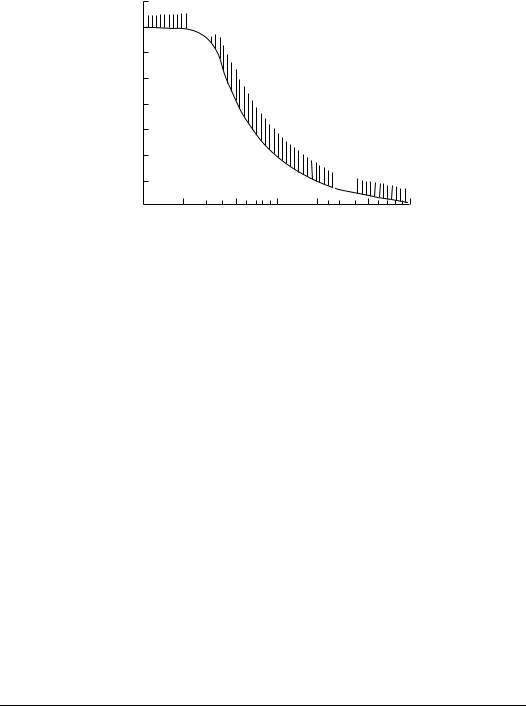
7-6 |
Biomechanics |
Compression (%)
40 Crushing injury
35
30
25
20 |
|
|
Viscous injury |
|
|
|
15 |
|
|
|
|
|
|
10 |
|
|
|
|
|
|
5 |
|
|
|
|
Blast injury |
|
|
|
|
|
|
|
|
0 |
2 |
5 |
10 |
20 |
50 |
100 |
1 |
||||||
Velocity of deformation (m/sec)
FIGURE 7.3 Biomechanics of chest injury by a crushing injury mechanism limited by tolerable compression at Cmax = 35%, a viscous injury mechanism limited by the product of velocity and extent of deformation at VCmax = 1.0 m/sec, and a blast injury mechanism for shock wave loading.
The roots of this approach involve military research. However, the clay may not adequately simulate the human viscoelastic properties and biomechanical responses. Recent research has defined the blunt ballistic characteristics of the chest and the mechanisms for ventricular fibrillation [Bir and Viano, 1999; Bir et al., 2004].
Sturdivan et al. [2004] developed the Blunt Criterion (BC) in the 1970s. It is energy based and assesses vulnerability to blunt weapons, projectile impacts, and behind-body-armor exposures. BC = ln[E /(W0.33 TD)], where E = 12 MV2 is the kinetic energy of the projectile at impact in Joules, M is the projectile mass in kg, V is projectile velocity in m/sec, D is the projectile diameter in cm, W is the mass of the individual in kg and T is body-wall thickness in cm. BC is an energy ratio. The numerator is the striking kinetic energy of the blunt projectile, the energy available to cause injury. The denominator is a semiempirical expression of the capacity of the body to absorb the impact energy without lethal damage to the vulnerable organs, scaled by the mass of the individual. The viscous and blunt criteria are both energy-based and have been correlated for chest and abdominal impacts.
Figure 7.3 summarizes injury mechanisms associated with torso impact deformation. For low speeds of deformation, the limiting factor is crush injury from compression of the body (C ). This occurs at C = 35–40% depending on the contact area and orientation of loading. For deformation speeds above 3 m/sec, injury is related to a peak viscous response of VC = 1.0 m/sec. In a particular situation, injury can occur by a compression or viscous responses, or both, as these responses occur at different times in an impact. At extreme rates of loading, such as in a blast-wave exposure, injury occurs with less than 10–15% compression by high-energy transfer to viscous elements of the body.
7.4 Biomechanical Responses During Impact
The reaction force developed by the chest varies with the velocity of deformation, and biomechanics is best characterized by a family of force-deflection responses. Figure 7.4 summarizes frontal and lateral chest biomechanics for various impact speeds. The dynamic compliance is related to viscous, inertial, and elastic properties of the body. The initial rise in force is due to inertia as the sternal mass, which is rapidly accelerated to the impact speed as the chest begins to deform. The plateau force is related to the viscous component, which is rate-dependent, and a superimposed elastic stiffness, which increases force
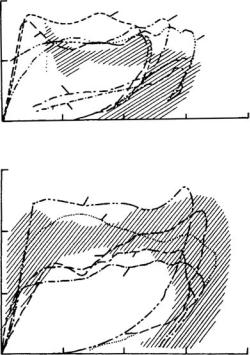
Biomechanics of Chest and Abdomen Impact |
7-7 |
Force (N)
800 |
|
|
(3559) |
6 |
5 |
3 |
4 |
|
|
400 |
|
(1779) |
|
|
2 |
Force (N)
1200
(5338)
800
(3559)
400
(1779)
1
1(25.4) 2(50.8) 3(76.2) 4(101.6) Total deflection (mm)
5
4
3 2
1
1(25.4) |
2(50.8) |
3(76.2) |
4(101.6) |
Total deflection (mm) |
|
||
FIGURE 7.4 Frontal and lateral force-deflection response of the human cadaver chest at various speeds of blunt pendulum impact. The initial stiffness is followed by a plateau force until unloading. (From Kroell et al., Proceedings of the 18th Stapp Car Crash Conference, pp. 383–457, SAE Paper No. 741187, Society of Automotive Engineers, Warrendale, PA, 1974, and Viano, Proceedings of the 33rd Stapp Car Crash Conference, pp. 113–142, SAE Paper No. 892432, Society of Automotive Engineers, Warrendale, PA, 1989, summarized by Cavanaugh J.M., The Biomechanics of Thoracic Trauma, In Accidental Injury: Biomechanics and Prevention, Nahum A.M. and Melvin J.W., (Eds.), pp. 362–391, Springer-Verlag, New York, 1993. With permission.)
with chest compression. Unloading provides a hysterisis loop representing the energy absorbed by body deformation.
Melvin et al. [1988] analyzed frontal biomechanics of the chest. The dynamic compliance is related to viscous, inertial, and elastic properties of the body. There is an initial rise in force, which is related to the inertia of the sternal mass, which is rapidly accelerated to the impact speed. This is followed by a plateau in force, which is related to the viscous properties and is rate dependent. There is also an elastic stiffness component from chest compression that adds to the force. The force-deflection response can be modeled as an initial stiffness k = 0.26 + 0.60(V − 1.3) and a plateau force F = 1.0 + 0.75(V − 3.7), where k is in kN/cm, F is in kN, and the velocity of impact V is in m/sec. The force F reasonably approximates the plateau level for lateral chest and abdominal impact, but the initial stiffness is lower at F = 0.12(V − 1.2) for side loading [Melvin and Weber, 1988].
The reaction force developed by the chest varies with the velocity of impact, so biomechanics is best characterized by the force-deflection response of the torso (25.6). The dynamic compliance is related to viscous, inertial, and elastic properties of the body. There is an initial rise in force, which is related to inertial responses as the sternal mass is rapidly accelerated to the impact speed. This is followed by a plateau in force, which is related to the viscous response and is rate dependent, and a superimposed stiffness component related to chest compression. By analyzing frontal biomechanics, the chest response can be modeled as
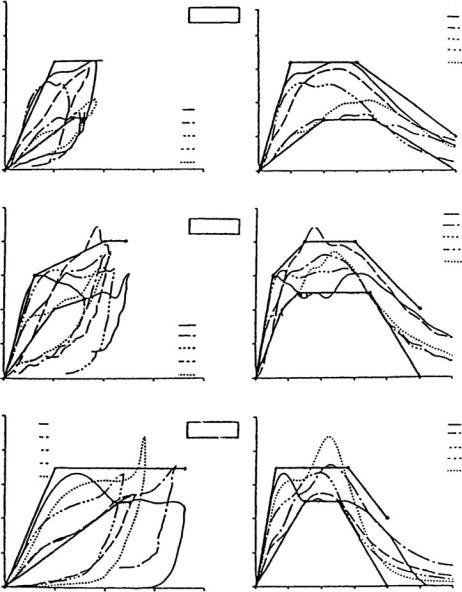
7-8 |
Biomechanics |
Force (kN)
Force (kN)
Force (kN)
5
4
3
2
1
0
0
5
4
3
2
1
0
0
5
run 2 run 14
4run 18 run 33
run 37
3
2
1
0
0
|
|
run 17 |
|
|
run 29 |
|
|
run 34 |
|
|
run 40 |
|
|
run 41 |
5 |
10 |
15 |
|
Deflection (cm) |
|
run 4 run 5 run 7
run 9 run 11
5 |
10 |
15 |
|
Deflection (cm) |
|
5 |
10 |
15 |
|
Deflection (cm) |
|
THORAX
4.4 m/sec
Force (kN)
20
6.5 m/sec
Force (kN)
20
9.5 m/sec
Force (kN)
20
5
4
3
2
1
0
0
5
4
3
2
1
0
0
5
4
3
2
1
0
0
10 20 30 40 Time (msec)
10 20 30 40
Time (msec)
10 20 30 40 Time (msec)
run 17 run 29 run 34 run 40 run 41
50 60
run 4 run 5 run 7 run 9 run 11
50 60
run 2 run 14 run 18 run 33 run 37
50 60
FIGURE 7.4 (Continued.)
an initial stiffness k = 0.26 + 0.60(V − 1.3) and a plateau force F = 1.0 + 0.75(V − 3.7), where k is in kN/cm, F is in kN, and the velocity of impact V is in m/sec. The force F reasonably approximates the plateau level for lateral chest and abdominal impact, but the initial stiffness is lower at F = 0.12(V − 1.2) for side loading.
A simple, but relevant, lumped-mass model of the chest was developed by Lobdell et al. [1973] and is shown in Figure 7.5. The impacting mass is m1 and skin compliance is represented by k12. An energy-absorbing interface was added by Viano [1987] to evaluate protective padding. Chest structure
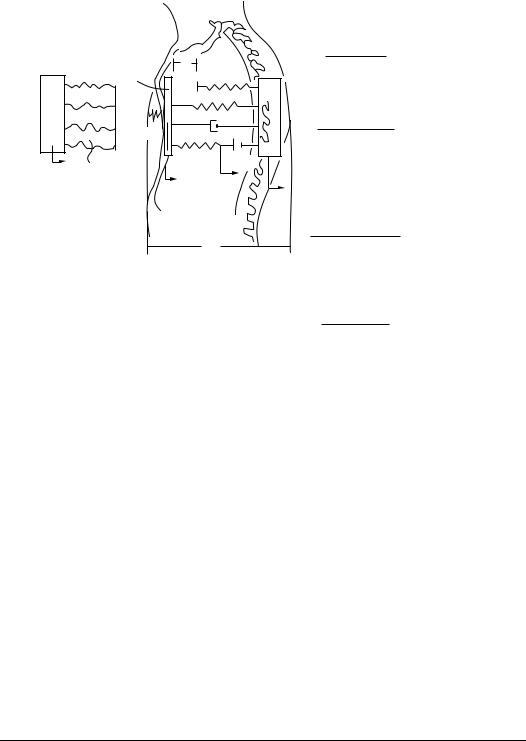
Biomechanics of Chest and Abdomen Impact |
|
7-9 |
||
|
|
|
Model |
AP thorax |
|
|
|
parameters |
hybrid III |
|
|
|
Masses (kg) |
|
m2 |
d |
k23S |
|
|
|
m2 |
0.45 |
||
|
|
|
||
m1 |
|
m3 |
m3 |
27.20 |
k12 |
c23 |
k23i |
Springs (kN/cm) |
|
|
k12 |
|
||
|
|
|
2.81 |
|
FC,CC |
kve23 cve23 |
k23i |
0.263 |
|
y1 |
y2 |
|
k23S |
0.526 |
|
y4 |
|||
|
|
kve23 |
|
|
|
|
y3 |
0.132 |
|
|
|
|
|
|
|
|
|
Dashpots (kN/m/sec) |
|
|
|
D |
C23 compression |
0.525 |
|
|
|
||
|
|
|
C23 tension |
0.230 |
|
|
|
cve 23 |
0.180 |
|
|
|
|
|
|
|
|
Distances (cm) |
|
|
|
|
d |
3.8 |
|
|
|
|
|
|
|
|
D |
22.2 |
FIGURE 7.5 Lumped-mass model of the human thorax with impacting mass and energy-absorbing material interface. The biomechanical parameters are given for mass, spring, and damping characteristics of the chest in blunt frontal impact. (Modified from Lobdell et al. Impact Response of the Human Thorax, In Human Impact Response Measurement and Simulation, King W.F. and Mertz H.J., (Eds.), Plenum Press, New York, pp. 201–245, 1973 by Viano, D.C., Proceedings of the 31st Stapp Car Crash Conference, pp. 185–224, SAE Paper No. 872213, Society of Automotive Engineers, Warrendale, PA, 1987. With permission.)
is represented by a parallel Voigt and Maxwell spring-dashpot system, which couples the sternal m2 and spinal m3 masses. When subjected to a blunt sternal impact, the model follows established force-deflection corridors. The biomechanical model is effective in studying compression and viscous responses. It also simulates military exposures to high-speed, nonpenetrating projectiles (Figure 7.6), even though the loading conditions are quite different from the cadaver database used to develop the model. This mechanical system characterizes the elastic, viscous, and inertial components of the torso.
The Hybrid III dummy was the first to demonstrate humanlike chest responses typical of the biomechanical data for frontal impacts [Foster et al., 1977]. Rouhana [1989] developed a frangible abdomen, useful in predicting injury for lap-belt submarining. More recent work by Schneider et al. [1992] led to a new prototype frontal dummy. Lateral impact tests of cadavers against a rigid wall and blunt pendulum led to side-impact dummies, such as the Eurosid and Biosid [Mertz, 1993]. Even more recently, a small female-sized side-impact dummy has been developed [Scherer et al., 1998].
7.5 Injury Risk Assessment
Over years of study, tolerances have been established for most responses of the chest and abdomen. Table 7.1 provides tolerance levels from reviews by Cavanaugh [1993], Rouhana [1993], and Viano et al. [1989]. While these are single thresholds, they are commonly used to evaluate safety systems. The implication is that for biomechanical responses below tolerance, there is no injury, and for responses above tolerance,
